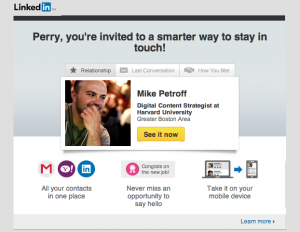So, LinkedIn is turning 10. The Next Web ran this comprehensive recap of the pivotal moments in its evolution — complete with jazzy infographic and a fun look back at its clunky 2003 web design.
LinkedIn’s main differentiator was being among the first user-generated content networks focused on expertise. As an early adopter (user 6818 — you can find your own member number embedded in your LinkedIn profile URL after “id=”), I pulled together some thoughts on what I’ve observed as milestones contributing to its success.
- Recognizing that they are a data company, and making some high-profile data scientist hires like Daniel Tunkelang — and enabling them to attract strong teams.
- Embracing mobile — a little late to the game, but a snazzy, much talked about tablet launch in 2012 and frequent updates since.
- Continuously improving the social aspects for average users sharing content — image integration that’s easy on the eyes, a longer character count than Twitter, a Like feature just like that other social network.
- Cracking the code for content original to LinkedIn. Other companies, like Facebook and Tumblr have shuttered similar efforts (here’s a good piece from RWW). While I’d argue that they have a natural advantage over Facebook and Tumblr in terms of shared audience purpose, they get credit for bringing in a range of thought leaders who make the site compelling and who become champions for the platform.
- Moving from text heavy resumes only to portfolio display opportunities — presumably the success of Bēhance and others has prompted LinkedIn to cast a wider net by supporting more visual experiences.
 Rolling out new applications like a new contact importing/ management service (see email offer at right — perhaps more compelling if the data pulls someone not in the office next to mine) that try to make LinkedIn the default drive for your connections.
Rolling out new applications like a new contact importing/ management service (see email offer at right — perhaps more compelling if the data pulls someone not in the office next to mine) that try to make LinkedIn the default drive for your connections.
While not a specific feature, I’d argue that LinkedIn’s ultimate killer app was shifting the social norm around job hunting. Back in the day, leaving a copy of your resume on the printer meant only one thing — you weren’t intending to stick around your current role very long. Now keeping your LinkedIn profile up-to-date is more a sign of career attention than looming transition. And arguably, in some fields today the bias is in precisely the opposite direction: people who don’t update their LinkedIn profiles are less likely to be actively engaged in their own career development — which as Tom Friedman reminded us last week in his bleak 401(K) world column, is a dangerous place to be.
No comments yet.